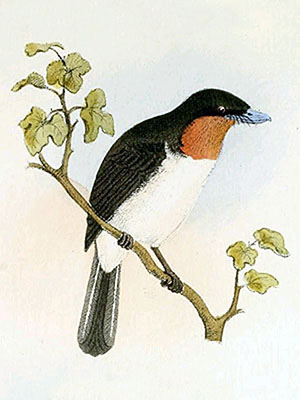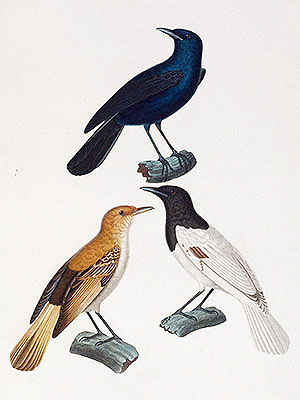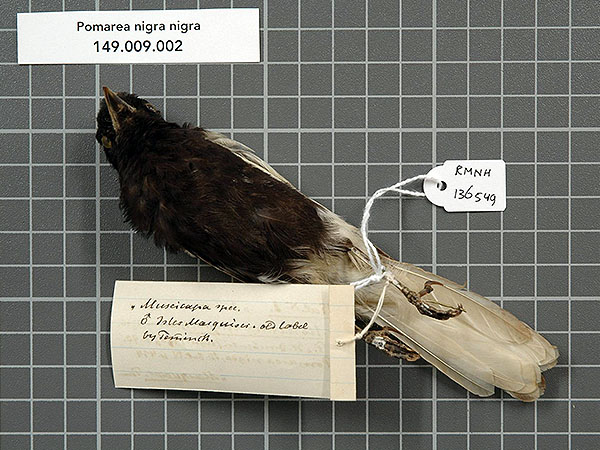Niihau Elepaio (Monarcha sp.)
The island of Ni’ihau, which is located very close to Kaua’i in the Hawaiian Islands, was once covered with typical Hawaiian lowland forests, which now are gone completely.
Today, the island harbors a few sea bird breeding colonies, but once it almost for certain also had several land bird species, some of which might very well have been endemic to the island; among these might have been a distinct form of Elepaio, which otherwise is known to inhabit the islands of Hawai’i, O’ahu and Kaua’i with distinct, island-specific species on each island.
*********************
edited: 07.05.2022
Tag Archives: Monarchidae
Monarcha nigra ssp. ‘Mo’orea’
Moorea Monarch (Monarcha nigra ssp.)
The Tahiti Monarch (Monarcha nigra (Sparrman)) is the sole surviving of formerly several monarch species that inhabited the Society Islands; as its name implies, it is endemic to Tahiti, the largest of the islands in the archipelago.
The smaller sister of Tahiti, Mo’orea, very likely once also harbored a monarch population, and this might well have been an endemic one.
*********************
edited: 07.05.2022
Myiagra sp. ”Eua’
Tongan Monarch (Myiagra sp.)
The Tongan Monarch is known from subfossil bones excavated on the island of ‘Eua.
The species is most closely related to the jeweled (Myiagra azureocapilla Layard) and the red-bellied monarch (Myiagra vanikorensis (Quoy & Gaimard)) of the Fiji Islands and the Samoan monarch (Myiagra albiventris(Peale)) (see illustration).
The islands of the Tongan archipelago most likely harbored several subspecies, each inhabiting neighboring island groups.
The Tongan Monarch disappeared, along with numerous other native bird species, due to the devastating destruction of natural vegetation on Tonga’s heavily populated islands.
********************

Depiction from: ‘O. Finsch; G. Hartlaub: Contribution to the fauna of Central Polynesia. Ornithology of the Viti, Samoa and Tonga Islands. Halle, H. W. Schmidt 1867’
(public domain)
********************
References:
[1] D. W. Steadman: Extinction and Biogeography of Tropical Pacific Birds. University of Chicago Press 2006
********************
edited: 04.12.2012
Monarcha mendozae ssp. mendozae (Hartlaub)
The Hiva Oa Monarch is the nominate form of a species that not only occurred on the islands of Hiva Oa and Tahuata but also on the neighboring island of Mohotani, where a distinct, endemic subspecies, the Mohotani Monarch (Monarcha medozae ssp. motanensis Murphy & Mathews), survives until today.
The species was locally known as kamokao atua respectively koma’o atu’a; the birds reached a length of 17 cm; the males of the nominate form were completely velvety black, while the females had a black head, the body was white with a pinkish tinge on the underside, the wings were black and white, the tail was white and had black subterminal spots.
The Hiva Oa Monarch disappeared from Tahuata shortly after 1922, when some specimens were collected by the Whitney South Sea Expedition; the very last record, however, was of a single bird that was seen in 1975 in a small valley of the O’otua Plateau on Hiva Oa. [1][2][3]
*********************
References:
[1] Robert Cushman Murphy; Gregory M. Mathews: Birds collected during the Whitney South Sea Expedition. V. American Museum Novitates 337: 1-18. 1928
[2] D. T. Holyoak; Jean-Claude Thibault: Contribution à l’étude des oiseaux de Polynésie orientale. Mémoires du Muséum national d’histoire naturelle 127(1): 1-209. 1984
[3] Jean-Claude Thibault; Jean-Yves Meyer: Contemporary extinctions and population declines of the monarchs (Pomarea spp.) in French Polynesia, South Pacific. Oryx 35(1): 73-80. 2001
*********************
edited: 08.05.2022
Monarcha mira (Murphy & Mathews)
The Ua Pou Monarch was described in 1928, originally as a subspecies of the Marquesan Monarch (Monarcha mendozae (Hartlaub)); it was endemic to the island of Ua Pou in the Marquesas.
The species was originally found all over the island, but in the 1970s its population was restricted to the higher elevations and its numbers were estimated to be about 150 to 200 pairs; these number soon dropped and finally, the last birds, two immature individuals, were seen in 1985 in the Hakahetau Valley near the north-western coast of the island.
The bird were locally known as pati’oti’o; the males were completely glossy black while the females were black with a white area covering the proximal two-thirds of the wings and a white tail. [1][2][3]
*********************
References:
[1] Robert Cushman Murphy; Gregory M. Mathews: Birds collected during the Whitney South Sea Expedition. V. American Museum Novitates 337: 1-18. 1928
[2] D. T. Holyoak; Jean-Claude Thibault: Contribution à l’étude des oiseaux de Polynésie orientale. Mémoires du Muséum national d’histoire naturelle 127(1): 1-209. 1984
[3] Jean-Claude Thibault; Jean-Yves Meyer: Contemporary extinctions and population declines of the monarchs (Pomarea spp.) in French Polynesia, South Pacific. Oryx 35(1): 73-80. 2001
*********************
edited: 08.05.2022
Monarcha fluxa (Murphy & Mathews)
The Eiao Monarch was described in 1928, originally as a subspecies of the Marquesan Monarch (Monarcha mendozae (Hartlaub)).
The males had the head, the nape, the chest and the upper tail coverts black with a very slight iridescence and variably mottled with white feathers, the wings were sooty black, the outermost one or two pairs of rectrices of the tail usually were white, but this character was very variable.
The forests that once covered Eiao are now highly reduced to little remnants; the last Eiao Monarchs were seen in 1977, all subsequent searches failed to find any remaining birds. [1][2][3]
*********************
References:
[1] Robert Cushman Murphy; Gregory M. Mathews: Birds collected during the Whitney South Sea Expedition. V. American Museum Novitates 337: 1-18. 1928
[2] D. T. Holyoak; Jean-Claude Thibault: Contribution à l’étude des oiseaux de Polynésie orientale. Mémoires du Muséum national d’histoire naturelle 127(1): 1-209. 1984
[3] Jean-Claude Thibault; Jean-Yves Meyer: Contemporary extinctions and population declines of the monarchs (Pomarea spp.) in French Polynesia, South Pacific. Oryx 35(1): 73-80. 2001
*********************
edited: 08.05.2022
Monarcha maupitiensis (Garnot)
This species was described in 1928, respectively in 1929; it is known exclusively from a painting, which again is depicting (in my opinion) a pair of the species as well as a juvenile bird (see depiction below).
The species did once inhabit the small island of Maupiti in the western leeward islands of the Society archipelago; this island has been completely deforested and is now covered with introduced vegetation.
The original endemic land bird fauna is not known, except for this one, rather enigmatic monarch species, but it may well have included several other species.
*********************

Depiction from: ‘Louis Isidore Duperrey; René-Primevère Lesson: Voyage autour du monde: exécuté par ordre du roi, sur la corvette de Sa Majesté, la Coquille, pendant les années 1822, 1823, 1824, et 1825. Vol. 5. Arthus Bertrand 1826
(public domain)
*********************
edited: 07.05.2022
Monarcha nukuhivae (Murphy & Mathews)
Nukuhiva Monarch (Monarcha nukuhivae)
The Nukuhiva Monarch was described in 1928, originally as a subspecies of the Marquesan Monarch (Monarcha medonzae (Hartlaub)); it was endemic to the island of Nuku Hiva, Marquesas.
The birds were locally known as kokohuia or pati’oti’o; they reached lengths of 17 cm; the males were completely velvety black, while the females had a black head and belly, the rump and belly were white, the wings were black and white, the tail was pure white.
The Nukuhiva Monarch was already on the brink of extinction when it was discovered; the last birds were seen in the 1930s, the species is now extinct. [1][2][3]
*********************
References:
[1] Robert Cushman Murphy; Gregory M. Mathews: Birds collected during the Whitney South Sea Expedition. V. American Museum Novitates 337: 1-18. 1928
[2] D. T. Holyoak; Jean-Claude Thibault: Contribution à l’étude des oiseaux de Polynésie orientale. Mémoires du Muséum national d’histoire naturelle 127(1): 1-209. 1984
[3] Jean-Claude Thibault; Jean-Yves Meyer: Contemporary extinctions and population declines of the monarchs (Pomarea spp.) in French Polynesia, South Pacific. Oryx 35(1): 73-80. 2001
*********************

female; note: this specimen was wrongly labeled!
Photo: Naturalis Biodiversity Center
(public domain)
*********************
edited: 08.05.2022
Monarcha gamberianus (Lesson)
The Mangareva Monarch is a very hypothetical species; there may once have been a specimen, collected on the island of Mangareva, Gambier Islands, and there may also have been a drawing of that specimens. Both are now lost, for whatever reasons.
There is now only the description of this bird.:
„Cette pie-grièche est fort voisine du Lanius tabuensis de Latham. Comme elle, on la trouve dans le mer du Sud, et c’est aux îles Gambier qu’elle vit. Cette espèce a les formes courtes et trapues. Elle mesure 14 centimètres. Ses ailes sont presque aussi longues que laqueue; son bec est peu crochu, bien que denté; il est noiràtre ainsi que les tarses; tout le plumage en dessus, les ailes et la queue sont d’un brun olivàtre uniforme; le devant du cou, à partir du menton jusqu’au haut de la poitrine, est olivàtre foncé; tout le dessous du corps, depuis le haut du thorax jusqu’aux couvertures inférieures, est du jaune le plus vif et le plus égal; les plumes tibiales sont brunes, mais cerclées d’une sorte de jarretiere jaune à d’articulation le dedans des ailes est varié de jaune et de blanc, ce qui forme un rebord étroit, blanc dessous du fouet de l’aile; la queue est légèrement échancrée, et le sommet des rectrices présente un point jaune.”
Translation:
“This shrike is very close to Lanius tabuensis [Aplonis tabuensis (Gmelin)] of Latham. Like this, it is found in the South Sea, and it lives in the Gambier Islands. This species has a short, squat form. It measures 14 centimeters. Its wings are almost as long as the tail; the beak is slightly hooked, but dentate; it is black as well as the tarsi; all the plumage above, the wings and the tail are uniformly olive brown; the front of the neck, from the chin to the top of the breast, is dark olive; the whole lower part of the body, from the top of the thorax to the lower coverts, is the liveliest and most even yellow; the tibial feathers are brown, but circled in a sort of yellow, hinged garter, the underside of the wings is varied with yellow and white, forming a narrow, white rim beneath the whip of the wing; the tail is slightly forked, and the top of the rectrices are dotted yellow.”
This description clearly relates to a starling, and in fact, the Mangareva Monarch might well actually have been a Mangareva Starling instead.
I’ll mention the whole story here only because I find it very intriguing.
*********************
References:
[1] R.-P. Lesson: Catalogue descriptif des oiseaux nouveaux, rares ou peu connus, de la collection Abeillé. L’Écho du monde savant et l’Hermès: journal analytique des nouvelles et des cours scientifiques. 1844 pt. 2: 232
*********************
edited: 07.05.2022
Hypothymis coelestis ssp. rabori Rand
Negros Celestial Monarch (Hypothymis coelestis ssp. rabori)
The 18 cm large, exceedingly beautiful Celestial Monarch is an endemic species of the Philippine Islands.
The species is curently split into two subspecies: the nominate form, which inhabits the islands of Basilan, Dinagat, Luzon, Mondanao, Samar as well as the Tawi-Tawi Islands, as well as the subspecies discussed here, which is known only from the island of Negros in the Visaya Islands group in the center of the Philippines.
(One specmen was allegedly found on the island of Sibuyan, I personally, however, think that this, for the sake of geographical reasons, is rather unlikely.)
***
The Negros Celestial Monarch was slightly larger than the nominate race and differed furthermore from it by its even longer, lighter-colored, glistening sky blue crown- and neck feathers, by the paler, less purplish blue-colored back and by the more extended grey areas on the lower breast, which furthermore appear to bear a somewhat bluish shimmer.
The Negros subspecies was last recorded in 1978 (?) and is considered very likely extinct. The main reason for its disappearance as well as for the progressing decline of the nominate form, is the still ongoing large-scaled destruction of the native forests in the Philippines.
***
This species is still highly under-researched and some of the island populations may also constitute distinct races.
*********************
References:
[1] A. L. Rand: Species formation in the blue monarch flycatchers genus Hypothymis. Natural History Bulletin of the Siam Society 23: 353–365. 1970
*********************

Depiction from: ‘Arthur Tweeddale: Contributions to the Ornithology of the Philippines. – No. IV. On the Collection made by Mr. A. H. Everett in the Islands of Dinagat, Bazol, Nipah, and Sakuyok. Proceedings of the Zoological Society of London 1878: 106-114’
(public domain)
*****************
edited: 24.10.2016
